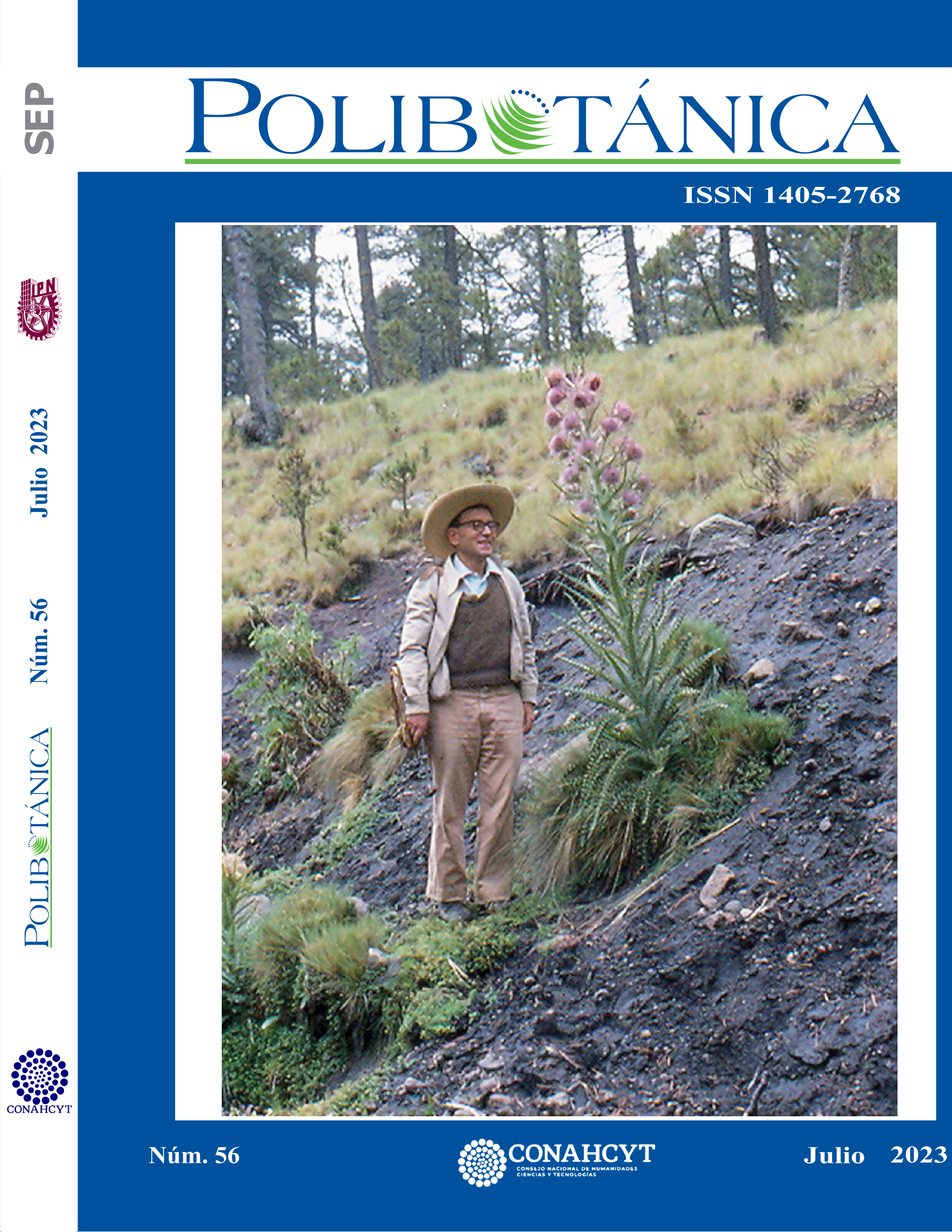Clinal variation of phenotypic and physiological characters in Pinus hartwegii Lindl., for the Zoquiapan Experimental Forest Station, Mexico
DOI:
https://doi.org/10.18387/polibotanica.56.4Keywords:
Pinus hartwegii, variación clinal, zonificación, cambio climático, movimiento de germoplasma.Abstract
In Mexico, low plant survival rates in reforestations undermine ecological restoration efforts, despite being a key activity in the recovery of habitats, biodiversity or ecosystem services. One of the reasons is the use of inadequate provenances. This influences resistance to cold and drought, or growth speed, so the germplasm used in reforestations should be (if possible) from the same geographical and altitudinal zone or lower altitude than the site to be reforested to compensate for the effects of climate change, in order to increase the probability of success in the establishment of individuals. The objectives of the work focused on determining the variation that exists among provenances for phenotypic traits of cones, seeds and needles; on identifying whether this is due to an environmental cline, and on delimiting provisional zones for germplasm supply. The sampling was carried out in eight natural provenances of Pinus hartwegii, originated every 50 m of altitudinal difference, along an altitudinal transect (from 3265 m to 3650 m), in the hill "El Papayo", Ixtapaluca, State of Mexico, Mexico. The variation among provenances and their altitudinal pattern was analyzed. Of the characteristics analyzed (seed length and width, cone length and greater aculeus length; germination capacity and speed), only seed length (p = 0.0058) and germination capacity (p < 0.0001) indicated differences between provenances. The altitudinal distribution pattern was quadratic for seed length (p = 0.0144 and r2 = 0.88) and germination capacity (p = 0.0456 and r2 = 0.7865). Two zones were delimited for germplasm supply and movement with widths of 200 m altitude and 1 ºC mean annual temperature. An increase in mean annual temperature of 2.3 ºC was estimated for the year 2060 with an RCP of 6.0 and an upward altitudinal movement of the populations of 400 m to compensate for it. Finally, guidelines for germplasm movement within and between zones with and without considering climate change are suggested.
References
Aparicio-Rentería, A., Viveros-Viveros, H., Hernández-Villa, J., Sáenz-Romero, C., Ruiz-Montiel, C., y Pineda Posadas, J. A. (2020). Zonificación altitudinal de Pinus patula a partir de conos y semillas en la sierra de Huayacocotla, Veracruz, México. Madera y Bosques, 26(2), 1–12. https://doi.org/10.21829/myb.2020.2621962
Capilla-Dinorin, E. (2018). Variación en indicadores reproductivos, germinación y crecimiento inicial de plántulas de poblaciones de Pinus chiapensis [Tesis de maestría, Colegio de postgraduados]. http://colposdigital.colpos.mx:8080/jspui/bitstream/10521/2977/1/Capilla_Dinorin_E_MC_Ciencias_Forestales_2018.pdf
Carbajal-Navarro, A., Navarro-Miranda, E., Blanco-García, A., Cruzado-Vargas, A. L., Gómez-Pineda, E., Zamora-Sánchez, C., Pineda-García, O`Neill, G., Gómez-Romero, M., Lindig-Cisneros, R., Johnsen, K. H., Lobit, P., Lopez-Toledo, L., Herrerías-Diego, Y., y Sáenz-Romero, C. (2019). Ecological Restoration of Abies religiosa Forests Using Nurse Plants and Assisted Migration in the Monarch Butterfly Biosphere Reserve, Mexico. Frontiers in Ecology and Evolution, 7(421), 1–16. https://doi.org/doi: 10.3389/fevo.2019.00421
Castellanos-Acuña, D., Lindig-Cisneros, R. A., Silva-Farias, M. Á., y Sáenz-Romero, C. (2014). Zonificación altitudinal provisional de Abies religiosa en un área cercana a la Reserva de la Biósfera de la Mariposa Monarca, Michoacán. Revista Chapingo Serie Ciencias Forestales y del Ambiente, XX(2), 215–225. https://doi.org/10.5154/r.rchscfa.2013.11.041
Castellanos-Acuña, D., Sáenz-Romero, C., Lindig-Cisneros, R. A., Sánchez-Vargas, N. M., Lobbit, P., y Montero-Castro, J. C. (2013). Variación altitudinal entre especies y procedencias de Pinus pseudostrobus, P. devoniana y P. leiophylla. Ensayo de vivero. Revista Chapingo Serie Ciencias Forestales y del Ambiente, XIX(3), 399-411. https://doi.org/doi: 10.5154/r.rchscfa.2013.01.002
Cervantes-Martínez, R., Cerano-Paredes, J., Sánchez-Martínez, G., Villanueva-Díaz, J., Esquivel-Arriaga, G., Cambrón-Sandoval, V. H., Méndez-González, J., y Castruita-Esparza, L. U. (2019). Historical bark beetle cutbreaks in Mexico, Guatemala and Honduras (1985-2015) and their relationship with droughts. Revista Chapingo serie ciencias forestales y del ambiente, 25(2), 269–290. https://doi.org/10.5154/r.rchscfa.2019.01.006
Chambel, M. R., Climent, J., Alia, R., y Valladares, F. (2005). Phenotypic plasticity: A useful framework for understanding adaptation in forest species. Investigación Agraria: Sistemas y Recursos Forestales, 14(3), 334–344. https://doi.org/10.5424/srf/2005143-00924
Del-Val, E. y Sáenz-Romero, C. (2017). Insectos descortezadores (Coleoptera: Curculionidae) y cambio climático: Problemática actual y perspectivas en los bosques templados. TIP. Revista especializada en ciencias químico-biológicas, 20(2), 53–60. https://doi.org/10.1016/j.recqb.2017.04.006
Farjon, A., Peréz de la Rosa, J. A., y Styles, B. T. (1997). Guía de campo de los Pinos de México y América Central (Primera). Continental Printing Bélgica.
Gómez‐Pineda, E., Sáenz‐Romero, C., Ortega‐Rodríguez, J. M., Blanco‐García, A., Madrigal‐Sánchez, X., Lindig‐Cisneros, R., Lopez‐Toledo, L., Pedraza‐Santos, M. E., y Rehfeldt, G. E. (2020). Suitable climatic habitat changes for Mexican conifers along altitudinal gradients under climatic change scenarios. Ecological Applications, 30(2), 1–17. https://doi.org/10.1002/eap.2041
Gómez-Pineda, E., Hammond, W. M, Trejo-Ramírez, O., Gil-Fernández, M., Allen, C. D., Blanco-García, A., Sáenz-Romero, C. (2022). Drought years promote bark beetle outbreaks in Mexican forests of Abies religiosa and Pinus pseudostrobus. Forest Ecology and Management, 505 (119944), 1-11. https://doi.org/10.1016/j.foreco.2021.119944
Guízar-Nolazco, E. (2014). MANUAL PARA IDENTIFICACIÓN DE BOTÁNICA FORESTAL MEXICANA (Primera). Universidad Autónoma Chapingo.
Hammond, W. M., Williams, A. P., Abatzoglou, J. T., Adams, H. D., Klein, T., López, R., Sáenz-Romero, C., Hartmann, H., Breshears, D. D., y Allen, C. D. (2022). Global field observations of tree die-off reveal hotter-drought fingerprint for Earth’s forests. Nature Communications, 13(1761), 1–11. https://doi.org/10.1038/s41467-022-29289-2
Iglesias, L., Solís-Ramos, L., y Viveros-Viveros, H. (2012). Variación morfométrica en dos poblaciones naturales de Pinus hartwegii Lindl. Del estado de Veracruz. Revista Internacional de Botánica Experimental. International Journal of Experimental Botany, 81, 239–246.
Iglesias-Andreu, L. G., y Tivo-Fernández, Y. (2006). Caracterización morfométrica de la población de Pinus hartwegii Lindl. del Cofre de Perote, Veracruz, México. Ra Ximhai, 2(2), 449–468.
López-Ríos, G. F. (2009). Ecofisiología de árboles (segunda). Universidad Autónoma Chapingo.
Loya-Rebollar, E., Sáenz-Romero, C., Lindig-Cisneros, R. A., Lobit, P., Villegas-Moreno, J. A., y Sánchez-Vargas, N. M. (2013). Clinal variation in Pinus hartwegii populations and its application for adaptation to climate change. Silvae Genetica, 62(3), 86–95. https://doi.org/10.1515/sg-2013-0011
Manzanilla-Quiñones, U., Aguirre-Calderón, Ó. A., Jiménez-Pérez, J., Treviño-Garza, E. J., y Yerena-Yamallel, J. I. (2019). Distribución actual y futura del bosque subalpino de Pinus hartwegii Lindl en el Eje Neovolcánico Transversal. Madera y Bosques, 25(2), 1–16. https://doi.org/doi: 10.21829/myb.2019.2521804
Marris, E. (2009). Planting the forest of the future. Nature, 459, 906–908. https://doi.org/10.1038/459906a
Méndez-Toribio, M., Martínez-Garza, C., Ceccon, E., y Guariguata, M. R. (2018). La restauración de ecosistemas terrestres en México: Estado actual, necesidades y oportunidades. Center for International Forestry Research (CIFOR). https://doi.org/10.17528/cifor/006853
Montero-Nava, R. M. (2020). Diferenciación de los indicadores reproductivos, sobrevivencia y crecimiento de plántulas de Pinus hartwegii procedentes de un gradiente altitudinal en el Parque Nacional La Malinche [Tesis de maestría]. Universidad Autónoma de Tlaxcala.
Niembro-Rocas, A. (1992). Variación dimensional y características morfológicas de semillas de 36 especies y variedades de pinos mexicanos. La ciencia y el hombre, 11, 107–143.
Ortiz-Bibian, M. A., Blanco- García, A., Lindig - Cisneros, R. A., Gómez-Romero, M., Castellanos-Acuña, D., Herrerías - Diego, Y., Sánchez-Vargas, N. M., y Sáenz-Romero, C. (2017). Genetic Variation in Abies religiosa for Quantitative Traits and Delineation of Elevational and Climatic Zoning for Maintaining Monarch Butterfly Overwintering Sites in Mexico, considering Climatic Change. Silvae Genetica, 66(1), 14–23. https://doi.org/DOI:10.1515/sg-2017-0003
Ortiz-Bibian, M. A., Castellanos-Acuña, D., Gómez-Romero, M., Lindig-Cisneros, R., Silva-Farías, M. Á., & Sáenz-Romero, C. (2019). Variación entre poblaciones de Abies religiosa (h.b.k.) schl. et cham a lo largo de un gradiente altitudinal. i. capacidad germinativa de la semilla. Revista fitotecnia mexicana, 42(3), 301–308.
Peñuelas, J., Ogaya, R., Boada, M., y S. Jump, A. (2007). Migration, invasion and decline: Changes in recruitment and forest structure in a warming-linked shift of European beech forest in Catalonia (NE Spain). Ecography, 30(6), 829–837. https://doi.org/10.1111/j.2007.0906-7590.05247.x
Pita-Villamil, J. M., y Pérez-García, F. (1998). Germinación de semillas (1a ed.). Ministerio de Agricultura, Pesca y Alimentación. https://www.mapa.gob.es/ministerio/pags/biblioteca/hojas/hd_1998_2090.pdf
Ramírez-Contreras, A., y Rodríguez-Trejo, D. A. (2009). Plantas nodriza en la reforestación con Pinus hartwegii Lindl. Revista Chapingo Serie Ciencias Forestales y del Ambiente, 15(1), 43–48.
Romahn-Hernández, L. F., Rodríguez-Trejo, D. A., Villanueva-Morales, A., Monterroso-Rivas, A. I., y Pérez-Hernández, M. de J. (2020). Rango altitudinal: Factor de vigor forestal y determinante en la regeneración natural del oyamel. Entreciencias: Diálogos en la Sociedad del Conocimiento, 8(22), 1–17. https://doi.org/DOI: 10.22201/enesl.20078064e.2020.22.72751
Ruíz-Talonia, L. F. (2010). Variación genética altitudinal entre procedencias de Pinus patula Schltdl. y Cham. En ensayos de vivero y campo en Ixtlán de Juárez, Oaxaca. [Tesis de maestría, Universidad Michoacana de San Nicolás de Hidalgo]. http://bibliotecavirtual.dgb.umich.mx:8083/xmlui/handle/DGB_UMICH/1832
Sáenz-Romero, C. (2004). Zonificación Estatal y Altitudinal para la Colecta y Movimiento de Semillas de Coníferas en México. En J. J. Vargas H., B. Bermejo V., & T. Ledig (Eds.), Manejo de Recursos Genéticos Forestales (Segunda edición). Colegio de Postgraduados; Universidad Autónoma Chapingo; CONAFOR.
Sáenz-Romero, C., y Linding-Cisneros, R. (2004). Evaluación y propuestas para el programa de reforestación en Michoacán, México. 37, 16, Ciencia Nicolaita.
Sáenz-Romero, C., Rehfeldt, G. E., Soto-Correa, J. C., Aguilar-Aguilar, S., Zamarripa-Morales, V., y y-Upton, J. (2012). Altitudinal genetic variation among Pinus pseudostrobus populations from Michoacán, México. Two location shadehouse test results. Revista Fitotenia Mexicana, 35(2), 111–120.
Thomas, E., Jalonen, R., Loo, J., Boshier, D., Gallo, L., Cavers, S., Bordács, S., Smith, P., y Bozzano, M. (2014). Genetic considerations in ecosystem restoration using native tree species. Forest Ecology and Management, 333, 66–75. https://doi.org/10.1016/j.foreco.2014.07.015
Thomas, S. C. (2011). Genetic vs. Phenotypic responses of trees to altitude. Tree Physiology, 31, 1161–1163. https://doi.org/d o i :10 .10 93/ t r e e p h y s / t p r10 5
Universidad Autónoma Chapingo. (2020). Estación Forestal Experimental Zoquiapan (EFEZ). http://dicifo.chapingo.mx/zoquiapan/
Uribe-Salas, D., Sáenz-Romero, C., González-Rodríguez, A., Téllez-Valdéz, O., y Oyama, K. (2008). Foliar morphological variation in the white oak Quercus rugosa Née (Fagaceae) along a latitudinal gradient in Mexico: Potential implications for management and conservation. Forest Ecology and Management, 256(12), 2121–2126. https://doi.org/10.1016/j.foreco.2008.08.002
Vargas Ríos, O. (2011). Restauración Ecológica: Biodiversidad y Conservación. Acta biológica. Colombiana, 16(2), 221–246.
Viveros-Viveros, H., Camarillo-Luna, A. R., Sáenz-Romero, C., y Aparicio-Rentería, A. (2013). Variación altitudinal en caracteres morfológicos de Pinus patula en el estado de Oaxaca (México) y su uso en la zonificación. Bosque, 34(2), 11–12. https://doi.org/10.4067/S0717-92002013000200006
Viveros-Viveros, H., Sáenz-Romero, C., Vargas-Hernández, J. J., López-Upton, J., Ramírez-Valverde, G., y Santacruz-Varela, A. (2009). Altitudinal genetic variation in Pinus hartwegii Lindl. I: Height growth, shoot phenology, and frost damage in seedlings. Forest Ecology and Management, 257(3), 836–842. https://doi.org/10.1016/j.foreco.2008.10.021
Downloads
Published
Issue
Section
License

Polibotánica by Departamento de Botánica de la Escuela Nacional de Ciencias Biológicas del Instituto Politécnico Nacional se distribuye bajo una Licencia Creative Commons Atribución-NoComercial-CompartirIgual 4.0 Internacional.




















